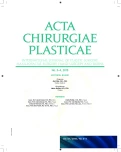A-07 Allogenous acellular dermal matrix in breast reconstruction – our experiences
Authors:
M. Boháč, KollerJ. 1 2; J. Fedeleš jr. 1; J. Fedeleš sen. 1
Authors‘ workplace:
Department of Plastic, Aesthetic and Reconstructive Surgery, Slovak Medical University and Medical Faculty of Komensky University in Bratislava, University Hospital Bratislava Ružinov, Slovakia
1; Department of Burns and Reconstructive Surgery, Medical Faculty of Komensky University in Bratislava, University Hospital Bratislava Ružinov, Slovakia
2
Published in:
ACTA CHIRURGIAE PLASTICAE, 57, 3-4, 2015, pp. 55-57
Category:
Selected abstracts from the 36th national congress of the czech society plastic surgery with international participation
Introduction
Acellular dermal matrix (ADM) is a soft tissue graft that is produced in a process of decellularisation preserving only intact extracellular matrix of the skin. After implantation is this structure able to create adequate scaffold for recipient’s cells with subsequent possible incorporation and revascularization. Its application has been validated in clinical practice by various methods, e.g. in burns, reconstruction of abdominal wall as well as breast reconstructions. ADM in breast reconstruction enables mainly coverage and subsequent shaping of the inferior pole of the breast. This enables more controlled placement of an implant, mainly towards the inframammary fold and also generally better and more ptotic shape of soft tissues in the inferior pole of the new breast. Such completely covered implant is more resistant against extrusion and also less visible and palpable. This presentation shows an effective application of allogenic ADM in breast reconstruction, which we verified also in our clinical conditions.
Methods
Our group of patients included 19 patients, in whom we performed 24 breast reconstructions using ADM with application of an expander during the last 18 months in the first stage. ADM for clinical application was prepared by the Central Tissue Bank of the University Hospital Bratislava Ružinov. In the second stage was performed exchange of the expander for permanent implants, during which there were also samples of soft tissues containing used ADM harvested. Biopsy samples of the tissues were furthermore analyzed histologically to see revascularization processes.
Results
During the period of 18 months we have seen two complications in 19 patients with 24 reconstructed breasts, who underwent reconstruction with the use of ADM. One patient developed infection caused by Streptococcus agalactiae with the need of explantation of the tissue expander. In the second patient developed mild deformation of shape in the inferior pole of the breast, most probably due to released insertion of ADM from the inframammary fold. In other cases, the use of ADM provided only benefits, mainly in significant shortening of surgical time and also reduced morbidity. All analyzed samples of ADM incorporated into soft tissues showed signs of revascularization without any tendency to rejection.
Conclusion
Effective use of ADM during reconstruction of the breast was verified also in our practice, for now however with the longest observation only of 18 months. Usage of this method will be therefore still subject of thorough long term analysis. Based on the current experience we can claim that the use of ADM clearly contributed to extension of the reconstructive options in our department. (Fig. 7.1, 7.2, 7.3, 7.4.)




Project support
This work was supported by VEGA grant, No. 1/0297/14, “New method of acellular dermis preparation for the use in reconstructive and plastic surgery”.
Sources
1. Zhong T et al.; MCCAT Study Group. The Multi Centre Canadian Acellular Dermal Matrix Trial (MCCAT): study protocol for a randomized controlled trial in implant-based breast reconstruction.Trials. 2013 Oct 28;14:356.
2. Macadam SA, Lennox PA. Acellular dermal matrices: Use in reconstructive and aesthetic breast surgery. Can J Plast Surg. 2012;20(2):75-90.
3. Forsberg CG et al. Aesthetic Outcomes of Acellular Dermal Matrix in Tissue Expander/Implant-Based Breast Reconstruction. Ann Plast Surg. 2014;72(6):S116–120.
Labels
Plastic surgery Orthopaedics Burns medicine TraumatologyArticle was published in
Acta chirurgiae plasticae

2015 Issue 3-4
- Metamizole vs. Tramadol in Postoperative Analgesia
- Metamizole at a Glance and in Practice – Effective Non-Opioid Analgesic for All Ages
- Current Insights into the Antispasmodic and Analgesic Effects of Metamizole on the Gastrointestinal Tract
- Spasmolytic Effect of Metamizole
- Obstacle Called Vasospasm: Which Solution Is Most Effective in Microsurgery and How to Pharmacologically Assist It?
Most read in this issue
- 36th NATIONAL CONGRESS OF THE CZECH SOCIETY OF PLASTIC SURGERY WITH INTERNATIONAL PARTICIPATION
- Dorsoradial forearm flap with silicone bone spacer in reconstruction of A combined THUMB injury – case report
-
ZORA JANŽEKOVIČ
(September 30, 1918 – March 17, 2015) - Editorial
